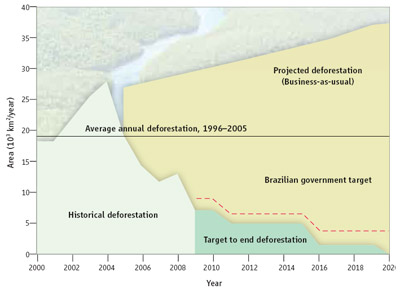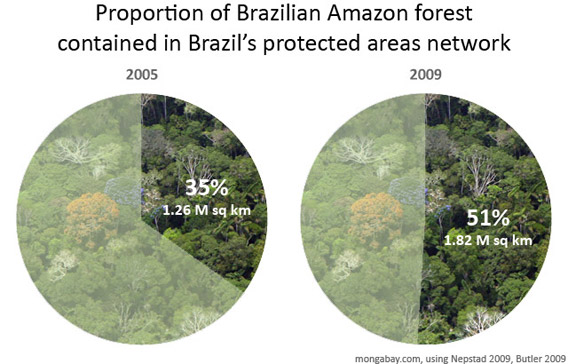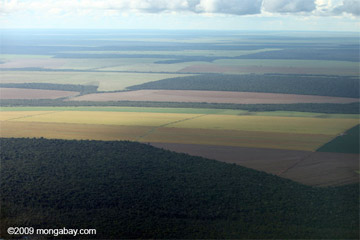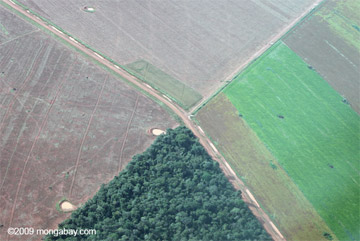Funds generated under a U.S. cap-and-trade or a broader U.N.-supported scheme to reduce greenhouse gas emissions from deforestation and degradation (“REDD”) could play a critical role in bringing deforestation in the Brazilian Amazon to a halt, reports a team writing in the journal Science. But the window of opportunity is short — Brazil has a two to three year window to take actions that would end Amazon deforestation within a decade.
Analyzing Brazil’s plan to cut Amazon forest clearing by 70 percent over the next decade and current efforts by major Brazilian beef and soy producers to exclude deforesters from the supply chain, Dan Nepstad of the Woods Hole Research Center and colleagues lay out a scenario under which net forest loss in the Brazilian Amazon could fall to zero by 2020. The external cost of the effort would be $7 to $18 billion, or 13-33 percent of what Americans spend annually on diet foods and beverages. Roughly half the payments would go towards establishing a forest peoples’ fund to pay for “community forest-based economic activities, health, education, and cultural preservation for the region’s indigenous, and traditional forest peoples and smallholder farmers.”

|
Ending deforestation in the Brazilian Amazon would reduce global carbon emissions 2-5 percent, safeguard the planet’s largest reservoir of terrestrial biodiversity, and ensure the continued provision of critical ecosystem services for Brazil and the world. It would also clearly establish Brazil as the leading player in the environmental services market, a sector expected to be worth hundreds of billions of dollars annually in the next 20 years. Brazil’s reduction in emissions from deforestation could alone generate $37 billion to $111 billion between 2013 and 2020 in revenue, some of which could be used to expand the program to end deforestation. Finally, eliminating Amazon deforestation in Brazil would send a powerful message to other countries, showing that it is indeed possible to protect the environment and benefit economically.
“Brazil has a 2-3 year window of opportunity to consolidate its gains in controlling Amazon deforestation,” Nepstad told mongabay.com.
“The political momentum is high today and the drivers of deforestation are still weak, and both of these conditions could change very soon,” he said, noting that Brazil will be holding elections in 11 months and the economy is poised to heat up, raising the prospect of increased demand for commodities produced in the Amazon.

|
“The potential is for Brazil to lock the world into a virtuous circle in which the REDD market grows strong, stimulating greater tropical forest governance (in Brazil and beyond), which feeds the REDD market. There is a huge surge in global demand for grains, beef, biofuel, that will undo the progress made leading up to, and beyond, Copenhagen, unless the important gains achieved thus far are secured.”
While it may seem far-fetched that deforestation in the Brazilian Amazon — the largest extent of rainforest in the world — can actually be halted, the Nepstad and colleagues are encouraged by a number of developments, including a dramatic drop in annual deforestation since 2005; a 50 percent increase in the amount of Brazilian Amazon under protection since 2005; and the emergence of environmental performance as a chief concern among buyers of commodities produced in the Amazon. This shift is perhaps best exemplified by the recent fallout from a June Greenpeace report, which linked illegal deforestation to leather and beef used by major consumer brands and supermarket chains.
 Patchwork of legal forest reserves, pasture, and soy farms in the Brazilian Amazon. Photo by Rhett A Butler |
Days after the report was released, Brazil’s biggest domestic beef buyers, supermarket chains Wal-Mart, Carrefour, and Pão de Açúcar, announced they would suspend contracts with suppliers found to be involved in Amazon deforestation. Bertin, the world’s second largest beef exporter, saw its $90 million loan from the World Bank’s International Finance Corporation withdrawn. Investigators raided the offices of JBS, the world’s largest beef processor, and other firms, arresting executives for corruption, fraud, and collusion. A Brazilian federal prosecutor filed a billion-dollar law suit against the cattle industry for environmental damage, warning that firms found to be marketing tainted meat will be subject to fines of 500 reais ($260) per kilo. Marfrig, the world’s fourth largest beef trader, said it would institute a moratorium on buying cattle raised in newly deforested areas within the Brazilian Amazon (Bertin echoed the moratorium in Augus, followed by JBS in October). BNDES, the development bank that accounts for most financing for the agricultural sector in Brazil, announced it would reform its lending policies, making loans contingent on environmental performance. Government ministers, financiers, and beef buyers called for a certification system that would ensure traceability through the cattle supply chain.
 Pasture and legal forest reserve near the Arc of Deforestation in the Brazilian Amazon. Photo by Rhett A Butler |
Such a system is already in existence. It has been developed over several years under an unusual partnership between a maverick Amazon cattle rancher named John Carter (a co-author on the Science paper) and some of the world’s most prominent environmental scientists (several of them also co-authors on the paper). The system, which is administered by Aliança da Terra, a Brazilian NGO run by Carter, is considered by some observers as a critical path towards rewarding environmental stewardship by ranchers and farmers operating in the Amazon while protecting key ecosystem functions of the planet’s largest rainforest.
“Ranchers and soy farmers are seeing the writing on the wall,” said Nepstad during a 2007 interview with mongabay.com. “If they want to sell into the growing international markets for their products, they need to obey the law and adopt sound land stewardship practices.”
“Aliança provides a credible mechanism for this to happen.”
Market recognition — in the form of carbon payments to responsible ranchers and farmers and/or higher prices for certified products — of these efforts is also critical. But compensation will have to expand beyond the “industrial” drivers of deforestation — benefits will have to reach a wide range of stakeholders across the Amazon. Again some models are already in place, including the Bolsa Floresta program in the state of Amazonas, which pays families a monthly stipend and gives them access to healthcare for maintaining forest cover. The scheme has proved so effective that it is already being adopted in other Brazilian states seeking to reduce deforestation.
But all these initiatives require some level of political commitment to ensure their ongoing success. Rooting out corruption, improving governance, improving land tenure systems, and enforcing existing laws will be critical in reducing deforestation in the Amazon in the long-term. Thus the fate of the world’s largest rainforest may depend as much on progress in these areas as it does carbon finance and market-based recognition for environmental performance by ranchers and farmers.
Related articles